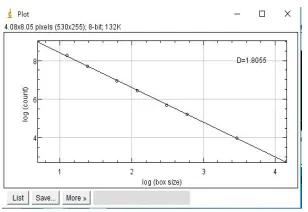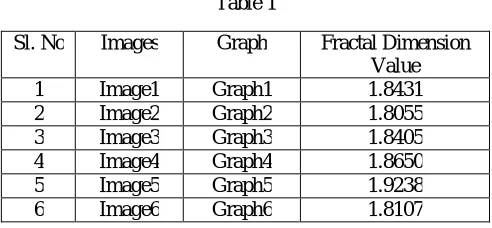Analysis of Fractal Dimension of Different
Images by Using Techniques of Image
Processing
K.Nithiyanandhan, Namratha K N
Asst. Prof. Department of Master of Computer Applications, Brindavan College, Bangalore, Karnataka, India
and Research Scholar, Rayalaseema University, Kurnool, Andhra Pradesh, India.
Asst. Prof. Department of Master of Computer Applications, Brindavan College, Bangalore, Karnataka, India
ABSTRACT: The present study deals with the fractal dimension analysis of images specifically jpg images using the techniques of Image Processing. Humans are very visual creatures. A large percentage of the human brain dedicates itself to visual processing. Images grabs our attention easily. When we see a picture, we analyze it within a very short time, knowing the meaning and scenario within it immediately. The human brain is able to recognize a familiar object within 100 milliseconds. Bright colors capture our attention because our brains are wired to react to them. This is often a fact that advertisers use to their advantage. The results are very informative and useful.
KEYWORDS: Image Processing, Fractal, Image.
I.INTRODUCTION
Image processing is the study of any algorithm that takes an image as input and returns an image as output. Includes:
Image display and printing
Image editing and manipulation
Image enhancement
Feature detection
Image compression
Image Processing is used in various applications such as: Remote Sensing
Medical Imaging
Non-destructive Evaluation Forensic Studies
Figure 1 Figure 2 Figure
Astronomy Satellite Imagery
Figure 4 Figure 5
Reasons Why Images are Important
If you have an online store, issue press releases or even just have a Face book business page, then here are 6 reasons to publish images and photos as part of your business marketing tactics.
1. Articles with images get 94% more total views
2. Including a Photo and a video in a press release increases views by over 45%
3. 60% of consumers are more likely to consider or contact a business when an image shows up in local search results
4. In an E-commerce site, 67% of consumers say the quality of a product image is “very important” in selecting and purchasing a product
5. In an online store, customers think that the quality of a products image is more important than product-specific information (63%), a long description (54%) and ratings and reviews (53%)
6. Engagement rate on Face book for photos averages 0.37% where text only is 0.27%
Figure 6
IMPORTANCE OF FRACTAL DIMENSION
A geometrical or physical structure having an irregular or fragmented shape at all scales of measurement between a greatest and smallest scale such that certain mathematical or physical properties of the structure, as the perimeter of a curve or the flow rate in a porous medium, behave as if the dimensions of the structure (fractal dimensions) are greater than the spatial dimensions.
The dimensional value of a fractal on a plane is always between one and two.
Applications of Fractal
Fractal in Medicine
Modern medicine often involves examining systems in the body to determine if something is malfunctioning. Since the body is full of fractals, we can use fractal math to quantify, describe, diagnose and perhaps soon to help cure diseases.
Fractal in Cities
phenomena as landscapes, soils, plant root systems, paths of foraging animals, and so forth. We also discuss the potential utility and limitations of a fractal approach, and outline how fractals have been used in ecology.
In [2] a study of recognition of plant leaf images is an important and difficult task. Extracting the texture feature of leaf images becomes the key to solve this problem in recent years. Considering some wavelet methods only focus on low-frequency sub-bands of images and some fractal dimension methods using a single exponent also cannot identify the images well, a novel wavelet fractal feature based approach for plant leaf images recognition is proposed. Firstly, the preprocessed leaf images are pyramid decomposed with 5/3 lifting wavelet transform and sub images are obtained. Then fractal dimensions of each sub images are calculated to be the wavelet fractal feature of leaf images. Finally back propagation artificial neural network is used to classify plant leaf images. The experimental results show that the proposed method can improve the performance for plant image recognition compared with methods using only wavelet or fractal dimension.
In [3] a study of Fractal dimensions of leaves from Cercis canadensis L., Robinia pseudoacacia L., Amelanchier arborea (F.Michx.) Fernald, Prunus persica (L.) Batsch, Quercus alba L., Carpinus caroliniana Walter, Ficus carica L., Morus rubra L., Platanus orientalis L., and Ulmus rubra Muhl. were calculated. The values were then confirmed and compared by those obtained from box-counting method and the exponent values of density correlation function (first time in the literature). It is now proposed for the first time that there is a relationship between a fractal dimension of the leaf and a surface density of the image and was concluded that together with other measures, the fractal dimensions with surface density function could be used as a new approach to taxonomical study of plants.
In [4] discussed on organisms support continual exchange with the environment so that they maintain in a state far from their thermodynamic equilibrium. The plants maintain themselves under low entropy conditions, a necessary prerequisite to life. The concept of fractal dimension to describe structures, which look the same at all length scales, was first proposed by Mandelbrot Objects are usually referred to as self-similar to indicate their scale-invariant structure. The common characteristic of such fractal objects is that their length depends on the length scale used to measure it, and the fractal dimension tells us the precise nature of this dependence. Estimation of fractal dimension of leaf shape was recently performed form various authors. We estimated Fractal Dimension of different kinds of leaves looking at their inner structure until to the cellular nucleus.
In [5] a review discussed an image analysis method based on the box counting algorithm was evaluated for its potential to characterize grapevine leaves. Although vine leaves lack the self-similarity of the theoretical fractals, leaves are candidates for characterization using fractal analysis because of their highly complex structure.
Some of the other works include ([6] to [12]).
PROBLEM SPECIFICATION
The main objective of the present study is to make a detailed analysis of the fractal dimension of different images by using the techniques of image processing. Different samples taken and the experiments are conducted.
III. METHODOLOGY
ImageJ tool is used to make detailed analysis of the fractal dimension of different images.
An image is an array, or a matrix, of square pixels (picture elements) arranged in columns and rows.
In a (8-bit) grayscale image each picture element has an assigned intensity that ranges from 0 to 255. A grey scale image is what people normally call a black and white image, but the name emphasizes that such an image will also include many shades of grey.
A normal grayscale image has 8 bit color depth = 256 grayscales. A “true color” image has 24 bit color depth = 8 x 8 x 8 bits = 256 x 256 x 256 colors = ~16 million colors.
Some grayscale images have more grayscales, for instance 16 bit = 65536 grayscales. In principle three grayscale images can be combined to form an image with 281,474,976,710,656 grayscales.
Colors
For science communication, the two main color spaces are RGB and CMYK.
RGB
The RGB color model relates very closely to the way we perceive color with the R, G and B receptors in our retinas. RGB uses additive color mixing and is the basic color model used in television or any other medium that projects color with light. It is the basic color model used in computers and for web graphics, but it cannot be used for print production.
The secondary colors of RGB – cyan, magenta, and yellow – are formed by mixing two of the primary colors (red, green or blue) and excluding the third color. Red and green combine to make yellow, green and blue to make cyan, and blue and red form magenta. The combination of red, green, and blue in full intensity makes white
Figure 7
IV.EXPERIMENTS AND RESULTS
The experiments are conducted with different images using ImageJ tool.
The results are presented in Table 1 and Figure 12 to Figure 17 and Graph 1 to Graph 6. RGB color Image Gray scale Image
Figure 9 Figure 10
Binary Image Determination of Fractal dimension Graph
Figure 11
RGB color Image1 Determination of Fractal dimension Graph1
Figure 12
RGB color Image2 Determination of Fractal dimension Graph2
Figure 13
Figure 14
RGB color Image4 Determination of Fractal dimension Graph4
Figure 15
RGB color Image5 Determination of Fractal dimension Graph5
Figure 16
Table 1
V. CONCLUSION
In this paper we pointed out the importance of fractal dimension of different images by using image processing techniques.Our results showed the different fractal dimension value with different irregular shapes in the images . The dimensional value of a fractal dimension on a plane is always between one and two.
ACKNOWLEDGEMENTS
One of the authors Mr. K.Nithiyanandhan acknowledges Brindavan College Bangalore, Karnataka and Rayalaseema University, Kurnool, India for providing the facilities for carrying out the research work.
One of the authors Mrs. Namratha K.N acknowledges Brindavan College Bangalore, Karnataka India for providing the facilities for carrying out the research work.
REFERENCES
1. N. C. Kenkel & D. J. Walker “Fractals and ecology”, ELTE, Budapest Abstracta Botanica 17(1-2): 53-70, 1993.
2. Haiyan Zhang Xingke Tao “Leaf Image Recognition Based on Wavelet and Fractal Dimension”, Journal of Computational Information
Systems 11: 1 141–148, 2015.
3. Mehmet bayirli, selami selvi and ugur cakilcioglu “Determining different plant leaves fractal dimensions A new approach to taxonomical study
of plants”, Bangladesh J. Bot. 43(3): 267-275, December 2014.
4. Elio Conte & Maria Pieralice on “Estimation of fractal dimension on inner structure of leaf samples by using the box counting method
“,IJRRAS Volume 6 Issue4 PP.48-59 October 2013.
5. S.Mancuso“Fractal geometry-based image analysis of grapevine leaves using the box counting algorithm “,Vitis 38 (3),97-100, 1999
6. V.Surendrababu , C.P.Sumathi E. Umapathy “Detection Rice Leaf Diseases Using Chaos Game and Fractal Dimension in Image Processing “
,IJCSE ISSN:0975-3397 Volume 6 No.01 January 2014.
7. Gregg Hartvigsan “ The Analysis of leaf shape using fractal geometry “ ,The American Biology Teacher Volume 62 No:9
November/December 2000.
8. B.B.Mandelbrot “Fractal Geometry: What is it, and what does it do?”, proceeding R.Soc.Lond.A423,3-16,1989.
9. Oancea Servilia “Fractal dimension of leaves from three species of Solanaceae”, Scientific Papers Journal agronomy series Volume 51(1) 2008.
10. Edrees, M. N. Mahmood “Applications of Fractal Dimension”,Iraqi Journal of Statistical Science (10) P.P. 54-73. 2006.
11. T. Pant “Effect of Noise in Estimation of Fractal Dimension of Digital Images” International Journal of Signal Processing, Image Processing
and Pattern RecognitionVol.6, No.5 , pp.101-116,2013.
12. Patnala S. R. Chandra Murty, E. Sreenivasa Reddy, and I. Ramesh Babu “Iris Recognition System Using Fractal Dimensions of Haar Patterns”
International Journal of Signal Processing, Image Processing and Pattern RecognitionVol. 2, No.3, September 2009.



